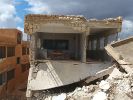Eye For Film >> Movies >> A Memory In Khaki (2016) Film Review
A Memory In Khaki
Reviewed by: Amber Wilkinson

Director Alfoz Tanjour uses the colour khaki as a conjurer of multiple memories in his contemplative documentary that weaves together his own experience of leaving Syria to seek asylum in Austria with those of other members of his homeland's diaspora, forced to flee the country's various oppressive regimes.
Khaki - Persian for dust-coloured - is, of course, most associated with Army uniform, with Tanjour visually evoking this in the film's first few moments as we see a child in uniform standing in the rain, with splashes of red chalk (another colour that will go on to have a significant presence in the film) at his feet. Throughout the documentary, the interviewees will also return to the colour - "we were against its symbolism," says one - and the psychological impact of its implications.

Where other documentarians, such as Feras Fayyad (Last Men In Aleppo) and Evgeny Afineevsky (Cries From Syria), thrust us into the war zone, here the footage of destruction is used sparingly. This, like Ziad Kalthoum's Taste Of Cement, is a mostly quiet but powerful portrait of exile, helping us to understand the weight of trauma that those who have fled often carry with them. This is perhaps most sharply illustrated in a scene in which we see refugees huddled on their journey to a potential new life as the horrific sound of bombings from another time, another place rings out.
One by one, the director and another filmmaking friend, his aunt, a writer and an artist, talk about the horrendous coping mechanisms developed while living in Syria. People, are considered property of the state, explains one, saying that when someone is arrested, you never ask 'Why?', only 'Where will they be taken?'. When those imprisoned return, their transformation was often so complete that "only the name matches".
These haunting vocal recollections of psychological suffering are given a thoughtful accompanying rhythm by Tanjour's carefully chosen visuals. Red paint, swirls like blood down a drain, rosy pomegranates glisten in sunlight and a child in a crimson jersey runs through a field - but is it in play or in flight?
This is less a portrait of a country than a journey through the emotional landscape of its people - here represented by the liberal, apparently secular class. Although this is a narrow focus, it is no less valid a choice than zeroing in on the citizen journalists of Raqqa in City Of Ghosts or the children in Cries From Syria. Like those films, it also illustrates how the affects of oppression and the fear generated by such regimes have a long reach.
Above all, it reminds us, if it were necessary, that becoming a refugee is more often than not a last-ditch attempt at survival - a situation that should make the words of president Donald Trump, played towards the end of the film, feel like a call to speak out for all those who have been 'born lucky' in countries where speaking out doesn't risk your life.
Reviewed on: 22 Mar 2018















